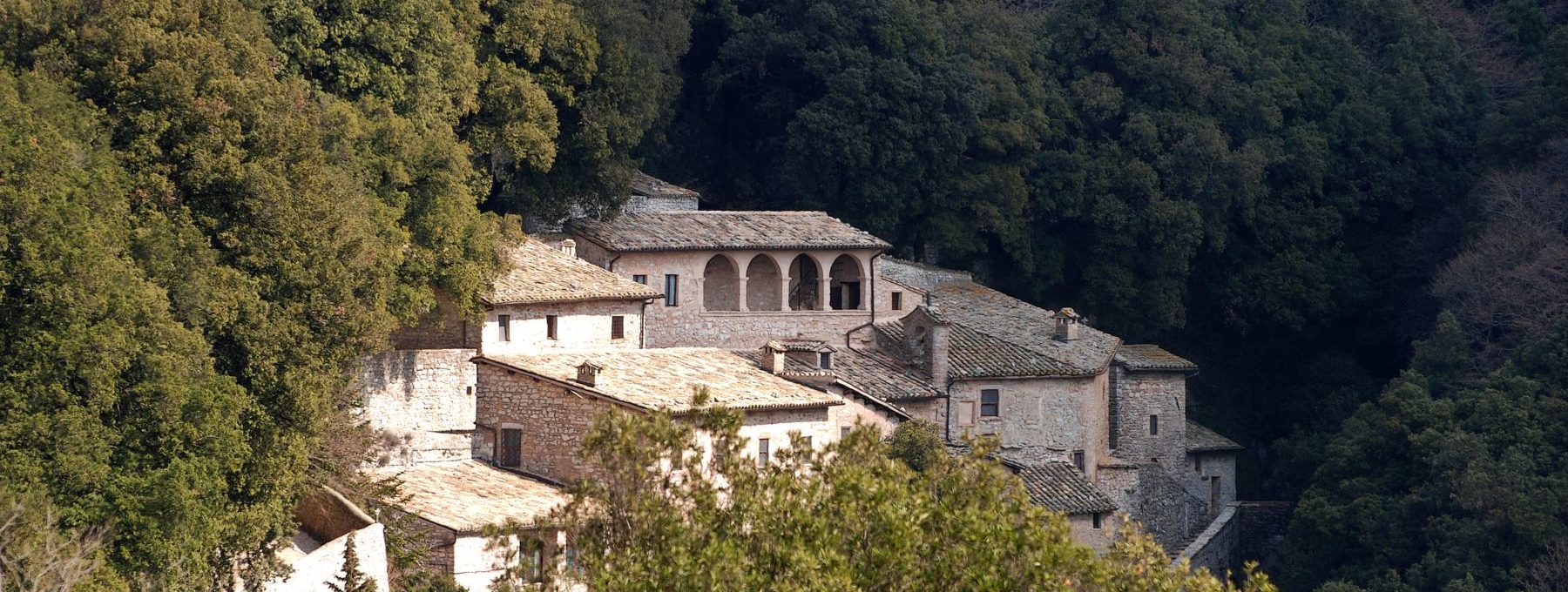When you get tired of walking Assisi’s busy streets, there is a place, far from the city centre, where “visiting” does not only mean “observing” and learning new information. Visiting this place, thanks to its history, position, and atmosphere means “living” a unique experience. Life here passes much more slowly than outside. The smells and the sounds that you are going to experience are the same that have been permeating it for 800 years. You are going to realise that at the Eremo della Carceri – about five kilometres (3 miles) from the city centre in the direction of Mount Subasio – the peace, contemplation, and spirituality that pervaded the Franciscan environments in the Middle Ages can be felt here like nowhere else.
In this case, the Latin word carceres refers to a place of retirement, penitence, and solitude. This is what Francis and his fellow friars did when they reached the tiny Chapel of Saint Mary and retreated in the caves and ravines that the mount offered to pray and meditate. Initially only the chapel marked that place, given to Francis ‒ as well as the Porziuncola ‒ by the Benedictine Monks of Subasio. Later, the friars built a small Oratory nearby and in the XV Century, by the will of the Vicar General S. Bernardino da Siena, the tiny Chapel was transformed into a tiny Church (although a lot more structured) and the triangular cloister facing the valley was added. More facilities were added by the Friars Minor – who have always been guarding the hermitage – until it took its final form in the XIX Century. On one hand the Rule that required friars to design small and frugal buildings, on the other their ingeniosity and creativity allowed them create this extraordinary complex that at times seems to merge with the cliff on which it was built.
Today one can visit the Chapel, the Oratory, and the caves where Francis and his companions spent their moments of solitude and meditation. The Cave of Francis, the first on the path from the Chapel to the Woods, only has two pieces of “furniture”, obviously made of stone: a flat bed and a rock that probably served as a seat. A small puncture on the floor marks the place where, according to the myth, the Devil had sunk after trying to tempt the Saint repeatedly. Outside the cave, a trail runs through the secular holly oaks where lie the historical caves where Leone, Egidio, Silvestro, Bernardo da Quintavalle, and Andrea da Spello would retire in prayer. One of the oldest trees of the wood – a sign promises it dates back to Francis’ time – was identified in the past as one the trees where Francis gave one of his famous sermons to the birds which, along with the Canticle of the Sun, made Francis the first environmentalist in history. Farther down the trail a bridge joins the two ribs of the mountain separated by a deep pit. According to the myth, there once was a creek running through the pit, but Francis had it drained by divine intervention, because it was disturbing his meditation. In fact, some studies hypothesised that – due to the carsic formation of the mountain – the spring only activates intermittently once every twenty or thirty years. Popular tradition links those events with some disgraces that occurred in the past, so the reactivation of the spring is regarded as a bad omen. Beyond the bridge we find the Chapel of Santa Maddalena. In 1477, Barnaba Manassei – the Franciscan friar that established the Mounts of Pity, the first credit institutions for the poor – was buried under it.
The Eremo delle Carceri offers a unique experience. Here history and myth intertwine, nature embraces spirituality, and the past merges with the present. By observing the life lead by a contemporary monk in the hermitage you will have a chance to experience one of the rare and precious testimonies of the Franciscan past and understand how the saint conceived the Rule. In his own words:
[136] Those who want to remain in hermitages to lead a religious life should be three brothers, or four at most; of these, let two be “mothers” and have two “sons,” or one at least. The two that are “mothers” should maintain the life of Martha and the two “sons” the life of Mary, and have a single enclosure, in which each may have his cell to pray and sleep in.
[137] And they are always to say Compline of the day immediately after sunset. And they should make sure to keep the silence. And they are to recite their Hours. And they are to get up for Matins. And let the first thing they seek be the kingdom of God and his justice. And let them say Prime at the appropriate hour and, after Terce, conclude the silence so that they can speak and go to their “mothers,” from whom, when they want to, they can beg an alms, like little paupers, for love of the Lord God.
[138] The “sons,” nonetheless, should now and then take over the duty of the “mothers,” according to what arrangement they have come to about taking turns at intervals. […]
(Franciscan Sources – St. Francis of Assisi’s Rule for Hermitages)
Our advice? Buy a map of the trails of Mount Subasio and take one of the many hikes that lead to the Hermitage. Everything is going to feel more authentic.



